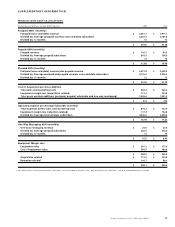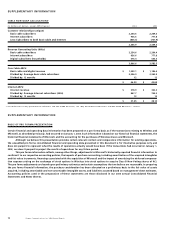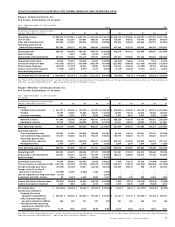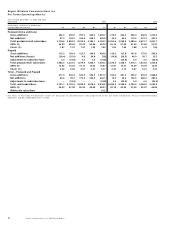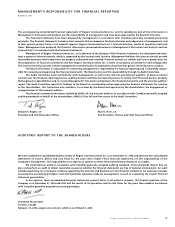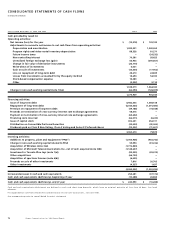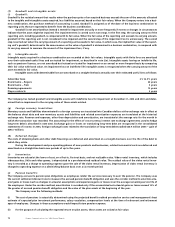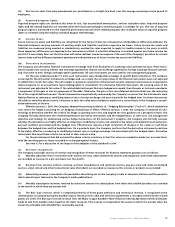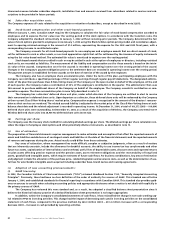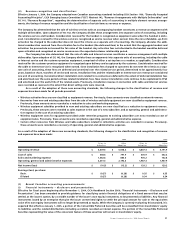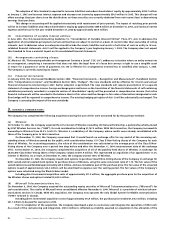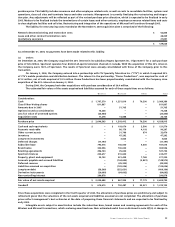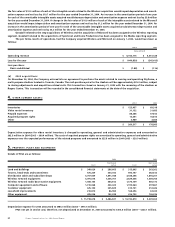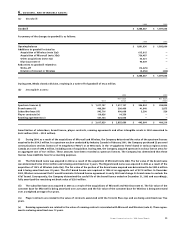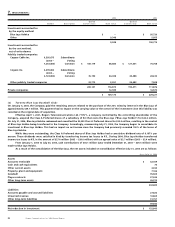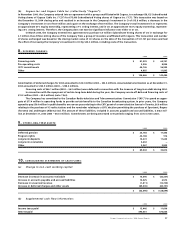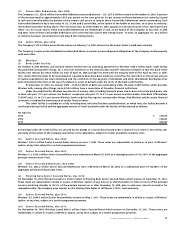Rogers 2004 Annual Report Download - page 81
Download and view the complete annual report
Please find page 81 of the 2004 Rogers annual report below. You can navigate through the pages in the report by either clicking on the pages listed below, or by using the keyword search tool below to find specific information within the annual report.
79
Rogers Communications Inc. 2004 Annual Report
(iii) Past service costs from plan amendments are amortized on a straight-line basis over the average remaining service period of
employees.
(k) Acquired program rights:
Acquired program rights are carried at the lower of cost, less accumulated amortization, and net realizable value. Acquired program
rights and the related liabilities are recorded when the licence period begins and the program is available for use. The cost of acquired
program rights is amortized over the expected performance period of the related programs. Net realizable value of acquired program
rights is reviewed using the industry standard daypart methodology.
(l) Income taxes:
Future income tax assets and liabilities are recognized for the future income tax consequences attributable to differences between the
financial statement carrying amounts of existing assets and liabilities and their respective tax bases. Future income tax assets and
liabilities are measured using enacted or substantively enacted tax rates expected to apply to taxable income in the years in which
those temporary differences are expected to be recovered or settled. A valuation allowance is recorded against any future income tax
asset if it is more likely than not that the asset will not be realized. Income tax expense is the sum of the Company’s provision for current
income taxes and the difference between opening and ending balances of future income tax assets and liabilities.
(m) Derivative instruments:
The Company uses derivative financial instruments to manage risks from fluctuations in exchange rates and interest rates. These instru-
ments include cross-currency interest rate exchange agreements, interest rate exchange agreements, foreign exchange forward contracts
and, from time to time, foreign exchange option agreements. All such instruments are only used for risk management purposes.
For the year ended December 31, 2003, such instruments were designated as hedges of specific debt instruments. The Company
accounted for these financial instruments as hedges and, as a result, the carrying values of the financial instruments were not adjusted
to reflect their current fair value. The net receipts or payments arising from financial instruments relating to interest were recognized in
interest expense on an accrual basis. Upon redesignation or amendment of a derivative financial instrument, the carrying value of the
instrument was adjusted to fair value. If the related debt instrument that was hedged was repaid, then the gain or loss was recorded as
a component of the gain or loss on repayment of the debt. Otherwise, the gain or loss was deferred and amortized over the remaining
life of the original debt instrument. These instruments were periodically reviewed by the Company to ensure that the instruments were
highly effective at reducing or modifying interest rate or foreign exchange risk associated with the hedged item. For those instruments
that did not meet the above criteria, variations in their fair value were marked-to-market on a current basis in the Company’s consoli-
dated statements of income.
Effective January 1, 2004, the Company adopted Accounting Guideline 13, “Hedging Relationships” (“AcG-13”), which established
new criteria for hedge accounting for all hedging relationships in effect. Effective January 1, 2004, the Company re-assessed all rela-
tionships to determine whether the criteria for hedge accounting were met, and applied the new guidance on a prospective basis. The
Company formally documents the relationship between derivative instruments and the hedged items, as well as its risk management
objective and strategy for undertaking various hedge transactions. At the instrument’s inception, the Company also formally assesses
whether the derivatives are highly effective at reducing or modifying currency risk related to the future anticipated interest and princi-
pal cash outflows associated with the hedged item. Effectiveness requires a high correlation of changes in fair values or cash flows
between the hedged item and the hedging item. On a quarterly basis, the Company confirms that the derivative instruments continue
to be highly effective at reducing or modifying interest rate or foreign exchange risk associated with the hedged items. Derivative
instruments that meet these criteria are carried at their intrinsic value.
For those instruments that did not meet the above criteria, variations in their fair value are marked-to-market on a current basis,
with the resulting gains or losses recorded in or charged against income.
See note 12 for a discussion of the impact of the adoption of this standard in 2004.
(n) Revenue recognition:
The Company’s principal sources of revenue and recognition of these revenues for financial statement purposes are as follows:
(i) Monthly subscriber fees in connection with wireless services, cable and Internet services and equipment, and media subscriptions
are recorded as revenue on a pro rata basis over the month;
(ii) Revenue from wireless airtime, roaming, wireless long-distance and optional services, pay-per-view and video-on-demand
services, video rentals and other transactional sales of products are recorded as revenue as the services or products are provided;
(iii) Advertising revenue is recorded in the period the advertising airs on the Company’s radio or television stations and the period in
which advertising is featured in the Company’s media publications;
(iv) Monthly subscription revenues received by television stations for subscriptions from cable and satellite providers are recorded
in the month in which they are earned; and
(v) The Blue Jays’ revenue, which is composed primarily of home game admission and concession revenue, is recognized as the
related games are played during the baseball season. Revenue from radio and television agreements is recorded at the time the related
games are aired. The Blue Jays received revenue from the Major League Baseball (“MLB”) Revenue Sharing Agreement which distributes
funds to and from member clubs, based on the clubs’ revenues. This revenue is recognized in the season in which it is earned, when the
amount is estimable and collectibility is reasonably assured.


